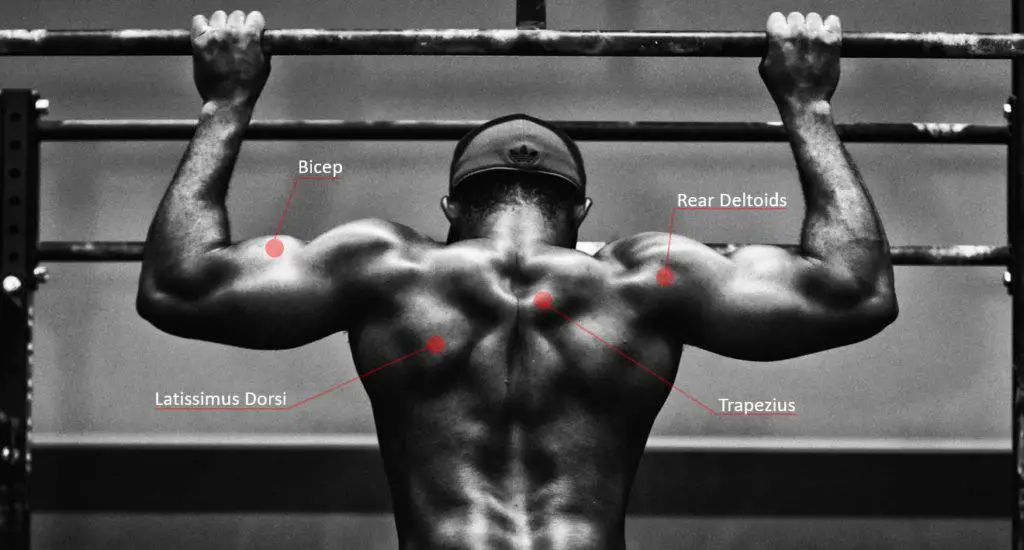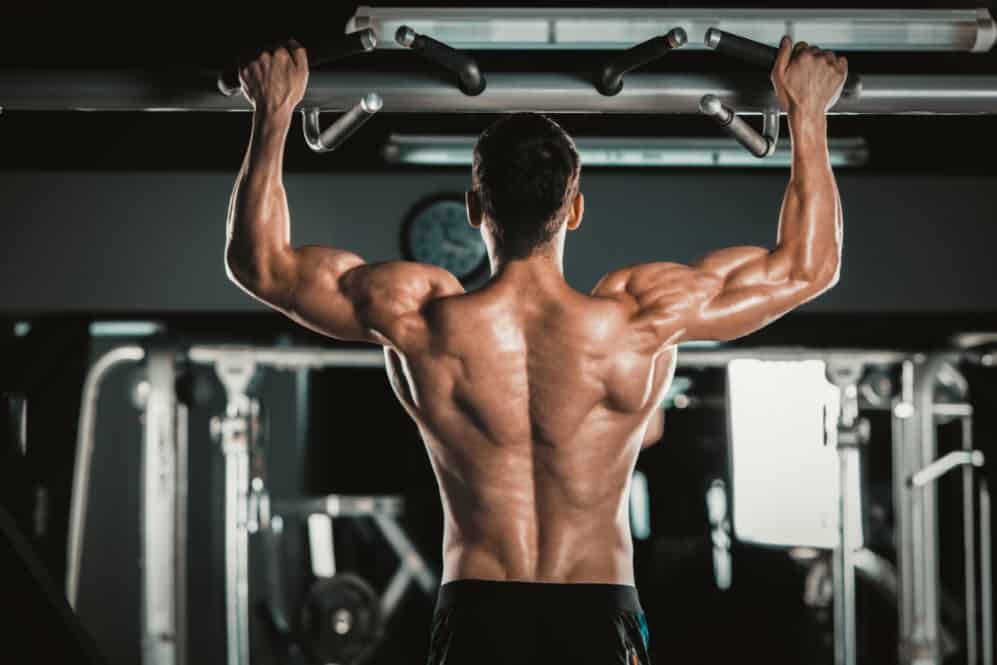It is not uncommon to see MMA fighters with defined pecs and particularly broad lats. The brawler type heavyweight fighters reach this body composition and structure by relying on upper body and back exercises like pull-ups. Are pull-ups good for MMA?
Pull-ups are good for MMA if you are incorporating striking as a dominant part of your fighting style. The exercise will strengthen your lats and help stabilize your shoulder. As a result, rapid and prolonged striking will not lead to as much exhaustion in a match.
The rest of this article covers everything you need to know about pull-ups in relation to mixed martial arts, including the common myths regarding the exercise and how to do pull-ups without injuring yourself.
Table of Contents
How to Do a Pull-Up
Pull-ups and chin-ups are great for your upper body strength and striking stamina if done right. However, if you use bad form, you can find yourself in the hospital or unable to step in the octagon. Make sure to follow the steps below while doing your pull-ups.
Connor McGregor shares his tips on how to perform the best close grip pull ups for MMA. The art of this is a slow, controlled movement the emphasise the stress on the lats and biceps. Forcing the elbows inwards during this movement also mimics the full guard in the striking game which The Notorious is known for.
Master Flexed Arm Hangs
The first step of strengthening your arms to handle pull-ups is to get the hang of flexed-arm hangs. As the name suggests, you start by grabbing a pull-up bar with your arms flexed. This is the position you usually see people achieve after they have finished the ‘up’ part of a pull-up and have lifted themselves up.
By holding the pull-up bar with your arms flexed, you are using the naturally strong muscles to support you in the position. As you take your legs off the stool, the flex arms will come under tension as you continue to hang for ten to twenty seconds. This will start increasing your arm strength without hurting the weaker muscles.
Master the Dead Hang
The second step in getting your upper body strong enough for regular pull-ups is to master hanging off the pull-up bar with your arms extended. This is the position in which the pull-up usually starts. Get on a stool at just the right height to be able to grab the pull up bar with your arms fully stretched.
Once you firmly grab hold of the bar, take your legs off the stool and let your weight put your arms and lats under stress as you continue to hang.
Go From a Flexed Arm Hang to a Dead Hang
Now that you have mastered the flexed-arm hang and can hang off a pull-up bar with your arms fully extended, it is time to get gravity involved. Though in a pull-up, you will be working against gravity, you will initially start by mastering how to go from flexed arm hang to a dead hang by slowly lowering yourself.
As you do this, you will be going along with gravity but lowering yourself as slowly as possible. This allows your arm muscles and your back to fight the gravity without going completely in the opposite direction. It will be a bit awkward to start with a flexed arm hang and lower yourself only to leave the bar and step on the stool once again to go to the flexed arm hang.
Go From a Dead Hang to a Flexed Arm Hang
There is no prescribed time for when you will be ready for this step. If you are already relatively fit, you could find yourself doing a pull-up in the first week of exercising. If you have not trained these muscles before, it could take a month or two, but you will realize on your own as you start to get comfortable pulling yourself up from a dead hang.
As you exercise going from a flexed muscle hang to a dead hang, you can try to go back up to a flexed arm hang without leaving the bar or stepping on the stool. If you can’t do it, the attempt is enough, as it will strengthen the muscles needed to pull yourself up. If you find yourself pulling your bodyweight all the way up, congratulations, you have finished a pull-up.
Can Pull Ups Help Grapplers?
Mixed martial artists fall under two broad categories. There are those who rely on striking while on their feet, and there are those who like to tackle and grapple on the ground. Overly simplifying this would mean there are those who are mostly wrestlers and then those who are boxers/kickboxers.
While pull-ups are often seen as a part of athletes’ training regimens in boxing, wrestlers have modified pull-ups to strengthen their grips. By using different grips when pulling yourself up, you become harder to get away from on the floor. Don’t let pull-ups remain a blessing for the strikes; if you’re into Brazilian Jiu-Jitsu or any other style of grappling, incorporate pull-ups into your training for an added advantage.
Pull-Ups and Physique
While pull-ups are a great exercise that helps your mixed martial arts performance, they also have an aesthetic outcome. By isolating the lats while exercising your biceps, triceps, and pecs, among other muscles, pull-ups can give you a nice symmetrical appearance with a defined V-shaped body and a defined chest and arms.
However, you need to make sure you are feeding yourself enough protein to encourage muscle growth and recovery. In fact, if you avoid taking the right amount of protein, you will cause injuries to your muscles by producing fatigue without nutrition.

Common Myths About Pull-Ups
The internet has come forth as a two-edged sword with information and disinformation battling for the same person’s attention. The exercise and fitness communities online are often victims of pseudo-science and assumed myths that get propagated on forums. Below are some of the common myths related to pull-ups.
You Need to Use a Wide Grip to Work Out Your Back
While it may seem visually obvious that doing pull-ups with a wide grip will make your back wider, the most strain put is on the top of your lats when doing pull-ups with a wide grip. This is good for shoulder stability but is not what makes one’s back wider. In fact, wide grip pull-ups do more for your chest than the width of your back. To get a wider back, you need to put your lower lats under stress, which happens with closed grip pull-ups.
Pull-Ups and Chin-Ups Refer to the Same Exercise
While many know that the exercises have the same motion, the different names sometimes get thrown interchangeably, which is unacceptable because of how different the outcomes of each of these are. With a pull-up, your hands face away, and your lats and back are a major focus of the action. With chin-ups, you have your hands facing towards you, and your biceps are the focus of the exercise.
While both exercises have different outcomes, they are appealing to the same class of fighter: the striker. That is because chin-ups help add force to your strike while pull-ups help you strike longer without getting as tired.
Final Thoughts – Are Pull-Ups Good for MMA?
Pull-ups are a great exercise that involves your body weight and adds strength to your back and stability to your shoulders. As a result, you can strike for longer periods and not get exhausted.
If you adjust your grips while doing pull-ups, you can increase the strength of your holds and take advantage of the exercise even as a grappler. Start by doing dead hangs from a pull-up bar, and then hang from the bar with your arms flexed. As you begin working your back and arm, remember to keep up your protein intake as well.

